I will explain you in a few easy steps how to draw with pastel pencils. Because pastel pencils can be sharpened to a very thin point they allow you to make very precise details on your drawing and are good for making portraits or studies.
Most manufacturers have a range of 80 pastel pencil colours but because you don’t have to buy them in sets I would recommend you to buy only a few for the beginning just to get the feel of what colour range is the best for you. Many of the painters dislike pastel pencils because they like the feeling of drawing with a pastel stick., that messier more intimate connection with the artwork.
There is not much difference in pastel pencils and pastel sticks. The main difference is in controlling the lines added because pastel pencils can be sharpened to a very tin point which makes them ideal for detailed drawings.
Several techniques can be applied when using pastel pencils for mixing the colours. Cross-hatching is one of them along with drawing different colour lines one next to other.
You can also apply thin layers of colour one on top of the other using the side of the lead to get the desired colour but when you work in this technique make sure you apply very thin layers because pastel pencils are very rich in pigments and leave a lot of residue on the paper.
Pastels also look very nice if you use your fingers to additionally blend them on the surface when they are already applied in layers. If you feel uncomfortable getting dirty you can always use a small piece of paper wrapped around your finger instead.
A nice effect can be gained if you use a wet clean brush to paint over the finished drawing. When the drawing is dried you can add additional layers of colour on it.
Drawing of seashells
Supplies needed for this drawing are:
- One sheet of grainy white watercolour paper
- Plastic eraser
- HB pencil
- Fixative
- Paper towel or a napkin
- Pink Beige
- Naples Yellow
- Cadmium Yellow
- Turquoise
- Orange
- Pale Purple
- Violet
- Dark Green
- Dark Blue
- Raw Sienna
- Dark Purple
- Black

Sketching
Use the HB pencil to place all the elements of your drawing in composition. Make fine thin lines hardly visible. Carefully draw the edges of seashells and the rope. Use the plastic eraser to partially erase the thickest lines with soft cross-hatching thus leaving palest thin contour. Use soft Pink Beige pastel pencil to draw contours of the seashells.
Start building the drawing using Naples Yellow to cover pink contours, defining shapes and form of seashells. Also, use it to fill some shaded areas. Do it with light moves applying very little pressure. Colours should be applied with hatching but you should leave a lot of white surfaces between the colour lines showing the whiteness of the paper.
Drawing in this manner will allow you to easier asses which colours and tones to youse next while building your composition. Next pencil you shall use is Cadmium Yellow and with it, you will draw the spiral ridges on the surface of the seashells and the rope.
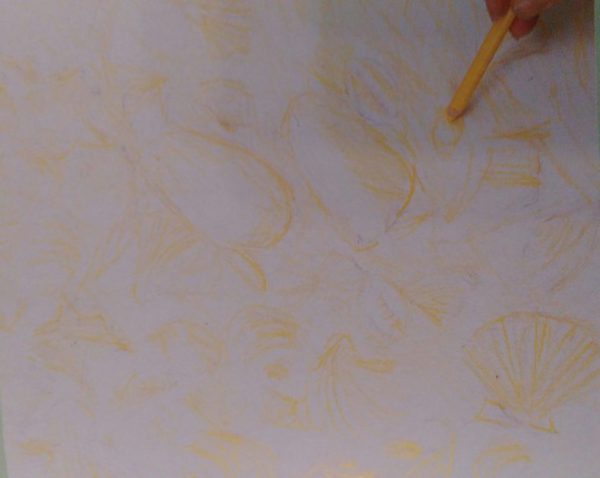
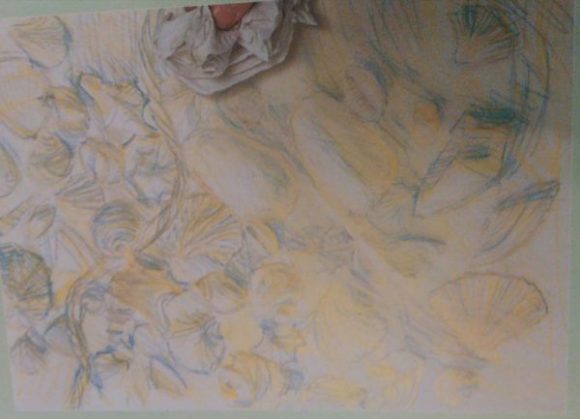
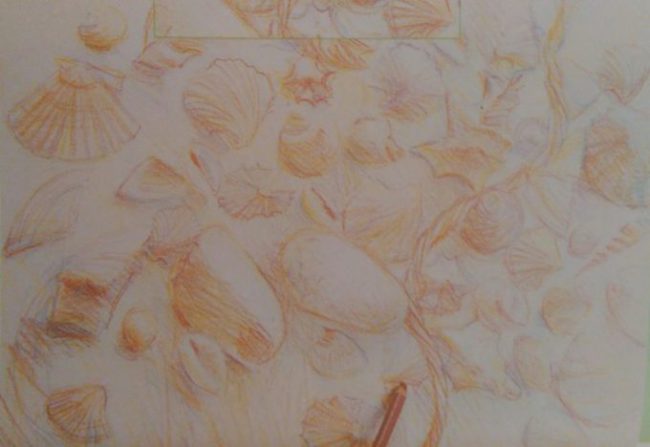
Giving shape and form to the objects
Start building shape and form of the objects on your drawing. Use Turquoise pencil to add colour over shaded areas with cross-hatching. Take the paper napkin and press it on to the paper but be careful not to rub the paper, you just want to remove that extra pastel pigment that is on the surface so you can later add additional layers of colour on your drawing.
With the tip of the purple pencil start drawing the shades in the ridges on the surface of seashells and emphasize the shades between the seashells. To emphasize on illuminated surfaces on the objects use the plastic eraser to remove added colour with short vertical moves.
Add shades to point out the slightest changes in the texture of the seashells using the colours which are most similar to colours of the seashells. Dark green colour should be used to emphasize green areas on seashells and with the dark blue and the dark purple you will add on the depth of shades. Work on the background colours too letting the whiteness of the paper come through and give life to the drawing.
Add lighter shades with long strokes of light blue to balance yellow tones that are widely used on the seashells. Use Raw Sienna to draw ridges on each seashell to emphasize the details.
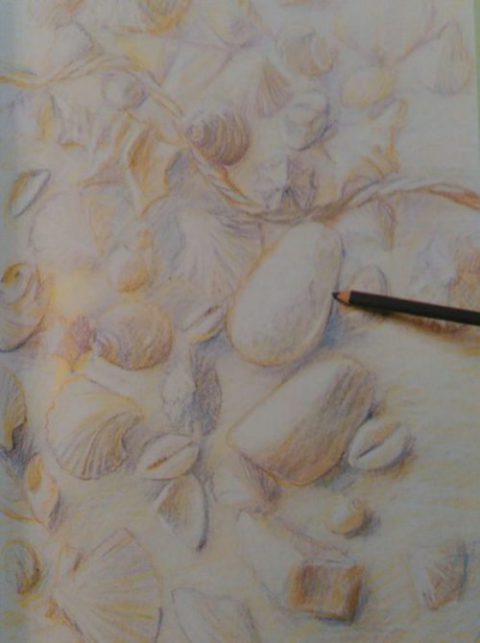
Finishing the drawing
Draw the edges of seashells and ridges on them with individual strokes of blue, purple and Raw Sienna. Drawn lines should follow the lines on the shells thus pointing out their individual shapes. To finish the drawing add a bit of Turquoise in the shades and with this black lines draw some of the edges in the front plane of the drawing.
Always try to make objects in the front plane of your drawings more detailed that will give your work the sense of depth and make it look more real.
Step away from your drawing, make sure you have the balance between the objects and colours on it if you think you need to add more details and shades. When you are completely satisfied with the results of your work you should use the fixative to protect it and keep it from smearing. Spray fixative from the distance so you don’t smear the colours on your drawing.
This was one way of using pastel pencils. Hope you will have fun while drawing. If you have any questions regarding the subject feel free to leave them below and I shall answer.

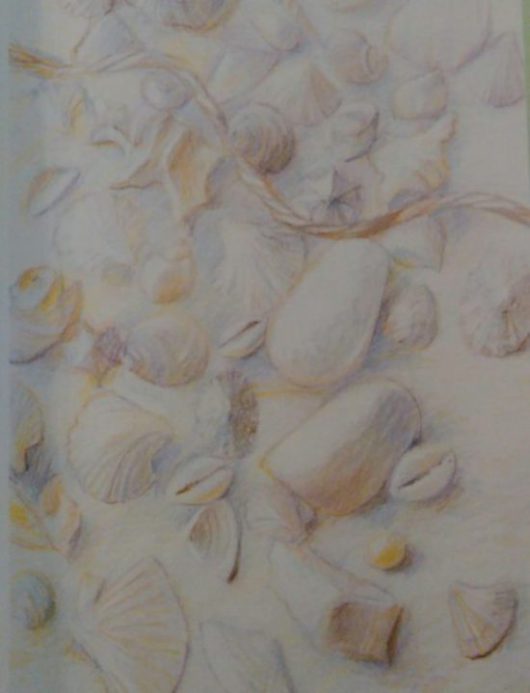



0 Comments